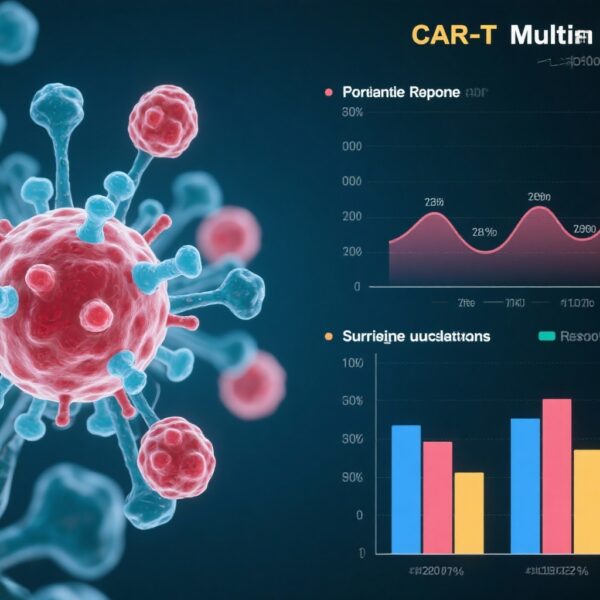Highlight
This genome-wide association study (GWAS) delineates genetic determinants distinguishing essential thrombocythemia (ET) and polycythemia vera (PV), two major myeloproliferative neoplasm (MPN) subtypes. The study confirms known loci influencing MPN phenotype, identifies nine replicated novel loci, and notably reveals a female-specific association at the CDH22/CD40 locus. Development of a polygenic risk score (PRS) demonstrates moderate predictive power improved by subtype optimization, indicating relevance for risk stratification and potential personalized approaches.
Study Background
Myeloproliferative neoplasms are clonal hematopoietic disorders characterized by the overproduction of one or more blood cell lineages, including ET and PV as predominant subtypes. These diseases are driven by somatic mutations such as JAK2 V617F but also have a hereditary component contributing to disease manifestation and phenotypic variability. Understanding the germline genetic architecture is crucial to unraveling the pathobiology of MPNs, informing prognosis, and identifying targets for intervention. Despite identifying several susceptibility loci, the genetic variation influencing MPN subtype determination and sex differences remains insufficiently characterized, representing a significant unmet need in hematologic oncology.
Study Design
This investigation employed a two-stage case-only genome-wide association study using cohorts aggregated from the United Kingdom (including UK Biobank), Spain, Germany, and Italy. The study compared ET and PV patients both against each other and against healthy controls to identify germline variants associated with MPN subtype risk. Stratified analyses examined the impact of chromosome 9p aberrations, JAK2 V617F mutation burden (a common somatic driver mutation), and sex on genetic associations. Genome-wide genotyping data underwent meta-analysis to pinpoint loci reaching genome-wide significance and nominal replication thresholds. A polygenic risk score encompassing 48 single nucleotide polymorphisms (SNPs) from 31 loci was constructed and performance assessed for subtype discrimination via area under the curve (AUC) metrics.
Key Findings
The comparative analysis between ET and PV reaffirmed the role of two known loci:
- HBS1L-MYB locus: Associated with increased ET risk (Pmeta=7.93×10-6, OR=1.28) and reduced PV risk (Pmeta=9.43×10-5, OR=0.81), highlighting its inverse relationship with these subtypes.
- GFI1B-GTF3C5 locus: Specifically predisposed to PV (Pmeta=1.43×10-9, OR=1.38), emphasizing its subtype specificity.
Most notably, two linked intronic SNPs, rs2425786 and rs2425788, at the CDH22/CD40 locus revealed a female-specific association (Pmeta=2.67×10-8) with increased PV risk (Pmeta=0.0006, OR=1.3) and decreased ET risk (Pmeta=7.82×10-5, OR=0.75). This sex-specific finding suggests a genetic basis for sexual dimorphism in MPN subtype expression.
The study confirmed associations at other significant loci including JAK2, TERT, ATM, TET2, PINT, GFI1B, and SH2B3 (all Pmeta < 5×10-8), emphasizing their robust roles in MPN susceptibility. Additionally, nine further loci replicated at nominal significance (Pmeta < 0.05), expanding the catalog of genetic factors linked to disease phenotype.
The polygenic risk score composed of 48 SNPs demonstrated moderate discriminative capacity for separating ET and PV with an overall AUC of 0.718. Optimization of the PRS for disease subtype further enhanced performance (AUCET=0.724 and AUCPV=0.755), supporting its utility for personalized risk stratification.
Expert Commentary
This comprehensive multi-cohort GWAS advances our understanding of inherited genetic contributions to MPN heterogeneity. The confirmation of established loci alongside new discoveries strengthens the biological rationale implicating hematopoietic regulatory genes. Notably, the identification of a sex-specific locus at CDH22/CD40 underscores the importance of considering sex as a biological variable in genetic association studies and may explain sex disparities observed in MPN subtype prevalence and outcomes.
While the PRS offers promising clinical application potential, its moderate predictive accuracy highlights that germline genetics represent one component of MPN pathogenesis, which is also influenced by somatic mutation burden, environmental exposures, and epigenetic modifiers. Future studies integrating multi-omic data and longitudinal clinical information will be necessary to refine risk models.
Limitations include potential population stratification despite meta-analytic adjustments and the need for validation in ancestrally diverse cohorts to ensure generalizability. Functional characterization of implicated SNPs, especially at the CDH22/CD40 locus, is required to elucidate pathogenetic mechanisms and potential therapeutic targets.
Conclusion
The study significantly enriches the genetic landscape of MPN subtypes by defining multiple germline variants that influence disease phenotype and identifying a novel female-specific association at CDH22/CD40. These findings enhance mechanistic insight into MPN ontogeny and reveal avenues for improved subtype-specific risk assessment and tailored therapeutic strategies. Further research is warranted to translate these genetic discoveries into clinical practice and deepen understanding of sex-based differences in MPN biology.
Funding and Clinical Trials
Details on funding sources and clinical trial registration were not reported in the source publication.
References
Tapper WJ, Dawoud AAZ, Score J, et al. Genome-wide analysis defines genetic determinants of MPN subtypes and identifies a sex-specific association at CDH22/CD40. Blood. 2025 Sep 30:blood.2025028489. doi: 10.1182/blood.2025028489. Epub ahead of print. PMID: 41026930.
Additional references from the literature are recommended for further reading on MPN genetics and polygenic risk scores.



